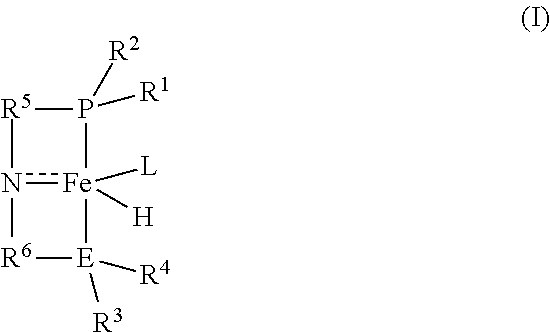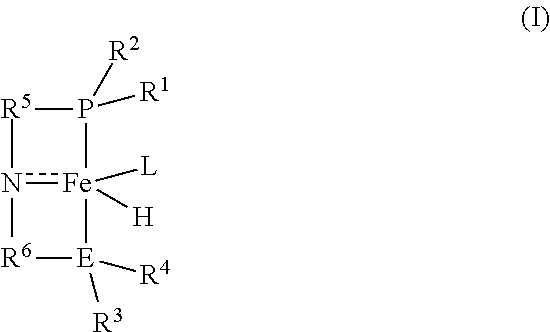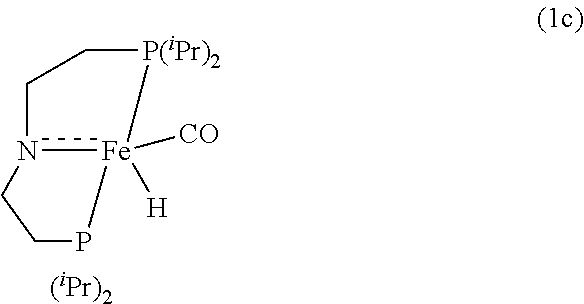Homogeneous iron catalysts for the conversion of methanol to methyl formate and hydrogen
a technology of iron catalysts and hydrogen, which is applied in the field of organic chemistry, can solve the problems of difficult bulk transportation, hazardous and flammable co gas used in the process, and achieve the effect of reducing the difficulty of bulk transportation
- Summary
- Abstract
- Description
- Claims
- Application Information
AI Technical Summary
Benefits of technology
Problems solved by technology
Method used
Image
Examples
example 1
[0096]Under a nitrogen atmosphere, a 10-mL Schlenk flask equipped with a stir bar and a cold-water condenser was charged with the Fe-MACHO pre-catalyst 1a (12 mg, 25 μmol, 1 mol %), NaOMe (3 mg, 50 μmol), anhydrous methanol (101 μL, 2.5 mmol), and benzene-d6 (˜1 mL). The resulting solution was refluxed for 1 h, the flask was then cooled to 0° C., and all the volatiles were vacuum transferred to a chilled J. Young NMR tube containing an internal standard, mesitylene (177 μL, 1.25 mmol). The resulting colorless solution was analyzed by 1H NMR spectroscopy, and the percent NMR yield (91%) of methyl formate was determined by the relative integrations of the aromatic CH resonance of mesitylene and formyl proton of methyl formate.
example 2
[0098]Under a nitrogen atmosphere, a 10-mL Schlenk flask equipped with a stir bar and a cold-water condenser was charged with the Fe-MACHO-BH pre-catalyst 1b (10 mg, 25 μmol, 1 mol %), anhydrous methanol (101 μL, 2.5 mmol), and benzene-d6 (˜1 mL). The resulting solution was refluxed for 1 h, the flask was then cooled to 0° C., and all the volatiles were vacuum transferred to a chilled J. Young NMR tube containing an internal standard, mesitylene (177 μL, 1.25 mmol). The resulting colorless solution was analyzed by 1H NMR spectroscopy, and the percent NMR yield of methyl formate (84%) was determined by the relative 1H NMR integrations of the aromatic CH resonance of mesitylene and formyl proton of methyl formate.
example 3
[0099]Example 2 was repeated, except that the resulting solution was refluxed for 2 hours. All of the methanol was converted to methyl formate. No other side products were formed in this reaction.
PUM
| Property | Measurement | Unit |
|---|---|---|
| temperature | aaaaa | aaaaa |
| temperatures | aaaaa | aaaaa |
| temperatures | aaaaa | aaaaa |
Abstract
Description
Claims
Application Information
 Login to View More
Login to View More - R&D
- Intellectual Property
- Life Sciences
- Materials
- Tech Scout
- Unparalleled Data Quality
- Higher Quality Content
- 60% Fewer Hallucinations
Browse by: Latest US Patents, China's latest patents, Technical Efficacy Thesaurus, Application Domain, Technology Topic, Popular Technical Reports.
© 2025 PatSnap. All rights reserved.Legal|Privacy policy|Modern Slavery Act Transparency Statement|Sitemap|About US| Contact US: help@patsnap.com



